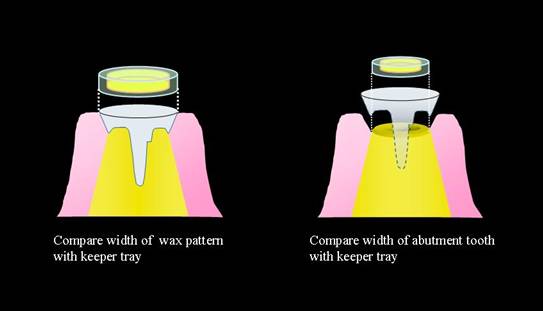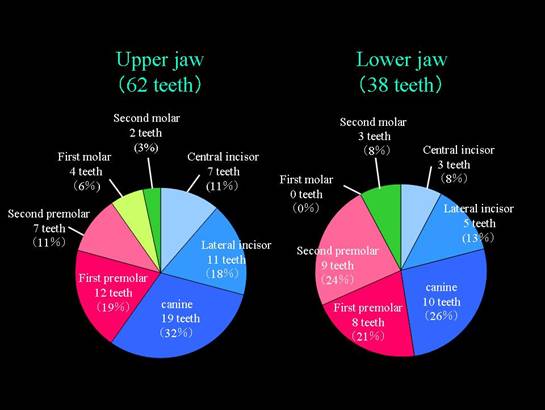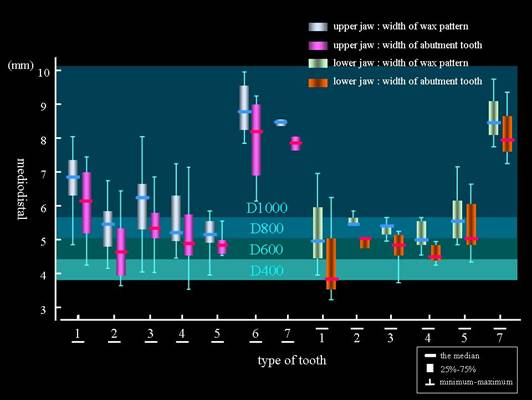| #5 Measurement of wax patterns of magnetic keeper coping |
||
| S. Okano1, E. Nagai11,2, K. Ohtani1,2, Y. Umekawa1,2, Y. Fukase3, T. Uchida1, M. Kiuchi1, N. Tsukimura1,2, Ishigami1,2 | ||
| 1 Department of Partial Denture Prosthodontics, Nihon University
School of Dentistry 2 Division of Clinical Research, Dental Research Center, Nihon University School of Dentistry 3 Division of Biomaterials Science, Nihon University School of Dentistry |
||
| Introduction |
| Recently, magnetic attachment has been used in prosthodontic treatments due to improve masticatory stability. We investigate what kind of magnetic keeper coping in clinical is worn. The purpose of this study was to investigate type of tooth with magnetic keeper coping, and measure the wax pattern made on working cast with artificial gum to select the keeper size. |
| Materials and Methods | ||
| 1. Type of tooth | ||
| Investigation period was 2007 to 2009. One hundred tooth of working cast with artificial gum of keeper coping was prepared, and type of tooth was investigated. | ||
| 2. Preparation of samples | ||
| Waxing up working cast with artificial gum was prepared (Fig.1). Reference surface have connecting mesial and distal gingival margins on waxing up. | ||
 |
||
| Fig.1 schema of wax pattern | ||
| Then, wax pattern was taken CT images with Microfocus X-ray CT system (Shimazu Corporation) respectively. And based on the obtained image, they were measured by analysis software CT-Solver (Shimadzu Corporation).Resolution of CT images was established as 23 micrometers to XY plane and the direction of Z. A measurement point is as follows (Fig.2). | ||
| a. length of post b. mesiodistal width of wax pattern (reference surface) c. mesiodistal width of abutment tooth |
||
 |
||
| Fig.2 measurement point | ||
| 3. Selection of keeper tray | ||
| Mesiodistal width (reference surface) of wax pattern and that of abutment
tooth was compared to select of keeper tray (Fig 3). Many dentists were hard to choose between, mesiodistal width (reference surface) of wax pattern or abutment tooth. |
||
 |
||
| Fig.3 compare width of wax pattern and abutment tooth with keeper tray | ||
| ResultsDiscussions | |||
 |
|||
| Fig.4 type of tooth | |||
| Figure 4 shows the type of tooth which was worn keeper coping. Both Upper jaw and Lower jaw, most used as abutment tooth with magnetic keeper was the canine tooth (32% and 26%). For upper jaw, next is first premolar(19%), lateral incisor(18%), central incisor(11%), first molar(6%), and then second molar(3%). For lower jaw, next is second premolar(24%), first premolar(21%), lateral incisor(13%), and then second molar and central incisor(8%). And first molar is out of use (0%) in this report. Because root of canine tooth is long, it often remains in oral. And it has high rates of life expectancy1) 2). Therefore advantageous condition was provided in clinical. | |||
 |
|||
| Fig.5 length of post | |||
| Lengths of each teeth post are showed in Fig.5. Based on a comparison of median, many teeth were approximately 4 to 6 mm. | |||
 |
|||
| Fig.6 compare mediodistal width of wax pattern and abutment tooth with keeper tray | |||
| Figure 6 shows mesiodistal width of wax pattern and abutment tooth. And horizontals line were keeper tray width etween D400 and D1000. For the all data of this sample, width of abutment tooth were smaller than width of wax pattern. Therefore there is a possibility that size of magneticP keeper was selected reference to cross-section of remaining root. | |||
| Conclusion |
| Base upon the results of this study, 1. Upper jaw and Lower jaw, most used as abutment tooth with magnetic keeper was the canine teeth (32% and 26%). 2. Post length was 4 to 6 mm. 3. It may be concluded that many dentist choose smaller size magnetic keepers tray. |
|
|
| References |
| 1) Yoshinobu T, The Application of the Sandwich-type Dental Magnetic
Attachment, "MAGFIT-600" in Various Clinical Cases, J Jpn
Prosthodont Soc, 36 : 471-480, 1992. (in Japanese) 2) Hisako Y, Clinical survey of dentures with magnetic attachments, The Journal of the Osaka Odontological Society 61(2):105-111, 1998. (in Japanese) |